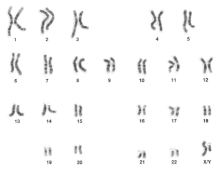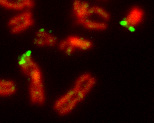Genetic differences and inheritance patterns

Inheritance of traits for humans are based upon Gregor Mendel's model of inheritance. Mendel deduced that inheritance depends upon discrete units of inheritance, called factors or genes. [1]
Autosomal dominant inheritance
Autosomal traits are associated with a single gene on an autosome (non-sex chromosome)—they are called "dominant" because a single copy—inherited from either parent—is enough to cause this trait to appear. This often means that one of the parents must also have the same trait, unless it has arisen due to an unlikely new mutation. Examples of autosomal dominant traits and disorders are Huntington's disease and achondroplasia.
Autosomal recessive inheritance

Autosomal recessive traits is one pattern of inheritance for a trait, disease, or disorder to be passed on through families. For a recessive trait or disease to be displayed two copies of the trait or disorder needs to be presented. The trait or gene will be located on a non-sex chromosome. Because it takes two copies of a trait to display a trait, many people can unknowingly be carriers of a disease. From an evolutionary perspective, a recessive disease or trait can remain hidden for several generations before displaying the phenotype. Examples of autosomal recessive disorders are albinism, cystic fibrosis.
X-linked and Y-linked inheritance
X-linked genes are found on the sex X chromosome. X-linked genes just like autosomal genes have both dominant and recessive types. Recessive X-linked disorders are rarely seen in females and usually only affect males. This is because males inherit their X chromosome and all X-linked genes will be inherited from the maternal side. Fathers only pass on their Y chromosome to their sons, so no X-linked traits will be inherited from father to son. Men cannot be carriers for recessive X linked traits, as they only have one X chromosome, so any X linked trait inherited from the mother will show up.
Females express X-linked disorders when they are homozygous for the disorder and become carriers when they are heterozygous. X-linked dominant inheritance will show the same phenotype as a heterozygote and homozygote. Just like X-linked inheritance, there will be a lack of male-to-male inheritance, which makes it distinguishable from autosomal traits. One example of an X-linked trait is Coffin–Lowry syndrome, which is caused by a mutation in ribosomal protein gene. This mutation results in skeletal, craniofacial abnormalities, mental retardation, and short stature.
X chromosomes in females undergo a process known as X inactivation. X inactivation is when one of the two X chromosomes in females is almost completely inactivated. It is important that this process occurs otherwise a woman would produce twice the amount of normal X chromosome proteins. The mechanism for X inactivation will occur during the embryonic stage. For people with disorders like trisomy X, where the genotype has three X chromosomes, X-inactivation will inactivate all X chromosomes until there is only one X chromosome active. Males with Klinefelter syndrome, who have an extra X chromosome, will also undergo X inactivation to have only one completely active X chromosome.
Y-linked inheritance occurs when a gene, trait, or disorder is transferred through the Y chromosome. Since Y chromosomes can only be found in males, Y linked traits are only passed on from father to son. The testis determining factor, which is located on the Y chromosome, determines the maleness of individuals. Besides the maleness inherited in the Y-chromosome there are no other found Y-linked characteristics.
Pedigrees analysis

A pedigree is a diagram showing the ancestral relationships and transmission of genetic traits over several generations in a family. Square symbols are almost always used to represent males, whilst circles are used for females. Pedigrees are used to help detect many different genetic diseases. A pedigree can also be used to help determine the chances for a parent to produce an offspring with a specific trait.
Four different traits can be identified by pedigree chart analysis: autosomal dominant, autosomal recessive, x-linked, or y-linked. Partial penetrance can be shown and calculated from pedigrees. Penetrance is the percentage expressed frequency with which individuals of a given genotype manifest at least some degree of a specific mutant phenotype associated with a trait.
Inbreeding, or mating between closely related organisms, can clearly be seen on pedigree charts. Pedigree charts of royal families often have a high degree of inbreeding, because it was customary and preferable for royalty to marry another member of royalty. Genetic counselors commonly use pedigrees to help couples determine if the parents will be able to produce healthy children.
Karyotype


A karyotype is a very useful tool in cytogenetics. A karyotype is picture of all the chromosomes in the metaphase stage arranged according to length and centromere position. A karyotype can also be useful in clinical genetics, due to its ability to diagnose genetic disorders. On a normal karyotype, aneuploidy can be detected by clearly being able to observe any missing or extra chromosomes. [1]
Giemsa banding, g-banding, of the karyotype can be used to detect deletions, insertions, duplications, inversions, and translocations. G-banding will stain the chromosomes with light and dark bands unique to each chromosome. A FISH, fluorescent in situ hybridization, can be used to observe deletions, insertions, and translocations. FISH uses fluorescent probes to bind to specific sequences of the chromosomes that will cause the chromosomes to fluoresce a unique color. [1]










